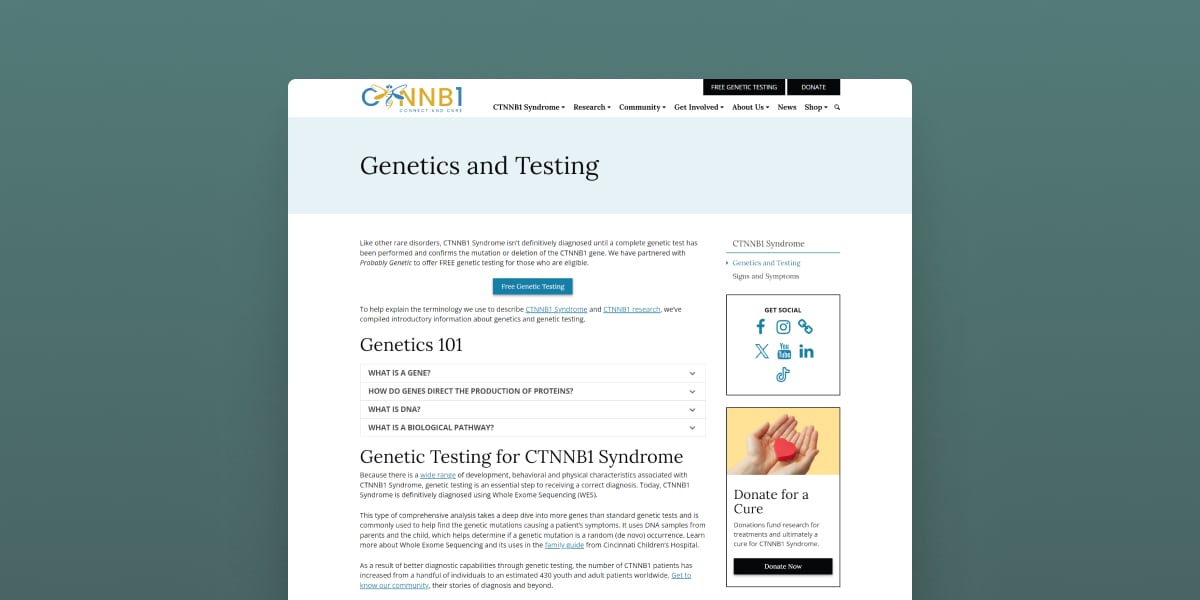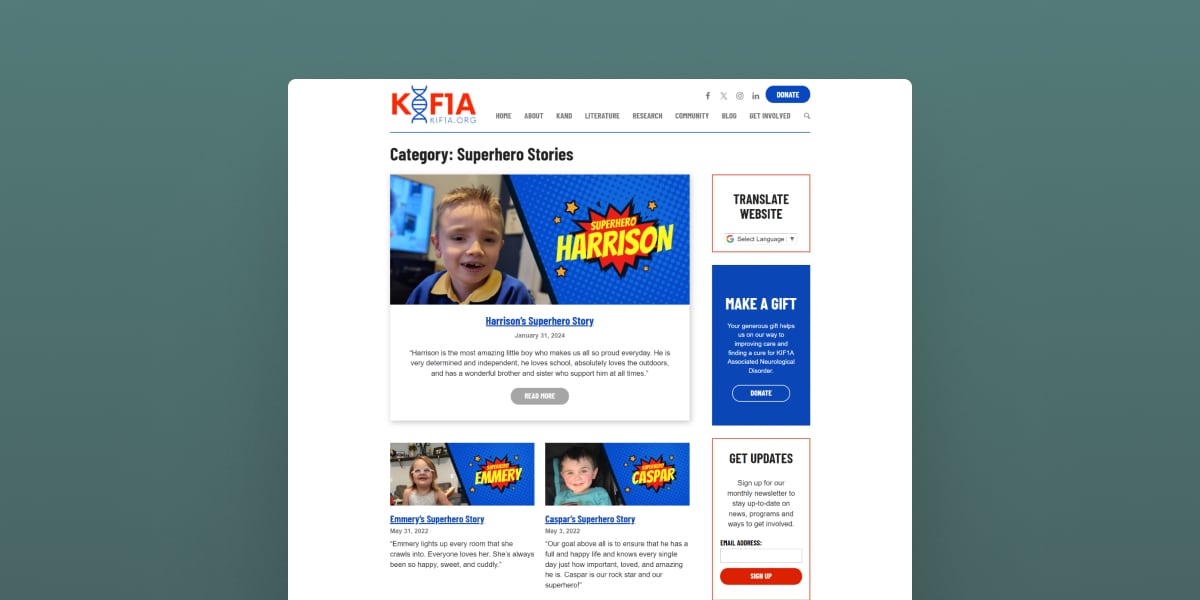It’s no secret our team believes a great website is a powerful tool for nonprofits. That’s especially true for those working in the rare disease space, who often face a unique set of challenges when building a site.
Not only are you working to connect a small yet dispersed audience, but you’re typically doing so with very few staff members. (And that’s if you’re lucky enough to have staff at all.)
In many cases, the catalyst for starting the organization in the first place is a founder’s deeply personal connection to the disease. That’s a lot for anyone to navigate, on top of all the work that goes into running an effective nonprofit.
But it’s precisely because of these challenges that a website is so valuable.
Done right, a rare disease nonprofit website can accelerate research, boost fundraising and offer essential resources, support and hope for your community.
Creating that kind of website does require some special considerations, so let’s dive in.
Understanding Your Audience
Knowing your audience and what they’re looking for is a great place to begin with any website project. As a rare disease organization, your website’s audience likely includes some combination of:
- Patients and families directly affected by the rare disease seeking information, resources, support and stories from others in their position.
- Healthcare professionals providing care to patients and families, looking for detailed information about the disease, diagnostic testing, treatment options and care.
- Research scientists and academics looking for published findings, ongoing studies or opportunities to collaborate on further study of the disease.
- Funders and supporters aiming to spread awareness and contribute through donations, grants, advocacy, volunteering, events and more.
As you set out to create your website, be clear from the start on who your primary audiences are, how you’d prioritize them and what you’re prepared to offer them through your site.
With that in mind, let’s explore website structures that work well for rare disease organizations.
Creating a Rare Disease Nonprofit Website Structure
It’s tempting to organize your website structure according to your audiences, with an entire section devoted to “Families” and another to “Healthcare Professionals” and so on.
But a structure like that doesn’t really account for audience overlap — which is one of the major reasons we recommend against organizing your site by audience.
Think of the parents of a young child with a rare disease diagnosis on a mission to learn all there is to know so they can be the best advocate for their kid in a doctor’s office, at their school and everywhere between.
Or a clinician who wants to read family stories so they can better understand their own patients and connect them with support options.
This doesn’t mean all pages have to speak to all visitors! But at the structure level, organizing pages by subject rather than reader can be a better way to connect your audience with the resources they need.
And that’s why I generally recommend an approach like this one.
![Illustration of a recommended structure for a rare disease nonprofit website. The top-level menu includes items for Home, About, [Rare Disease Name], Community, Research, Blog, and Get Involved. Each top-level tab has a drop-down menu with further options.](https://wiredimpact.com/wp-content/uploads/2024/02/rare-disease-nonprofit-website-example-structure-1265x364.png)
Obviously this is a sample structure, which you can and should customize to fit your unique needs. But approaching it from this perspective will help you clearly introduce your organization, educate visitors and offer support to your community.
Now, let’s break down each section of pages.
About
The majority of first-time visitors to your site will likely be searching for information related to the rare disease itself. But establishing your credibility with these visitors requires you to share some background about your organization, too.
This section of your site gives you space to share how the organization was founded, your story, the team powering your work and the impact of your efforts so far — all of which builds trust with your audience.
Disease Information
A section dedicated to what you do (and don’t) know about the rare disease can be a helpful place to start for visitors just beginning their journey.
Here you can share details about signs and symptoms, what kind of testing is required or encouraged, what obtaining a diagnosis looks like, the role of genetic factors, and common misdiagnoses or co-occurring diagnoses worth monitoring.
The Genetics and Testing page of the CTNNB1 Connect and Cure website is a great example. Visitors can quickly learn how the syndrome is diagnosed, whether they’re eligible for free genetic testing, how to read and interpret genetic results and find answers to FAQs.

The page is easy to find within the CTNNB1 Syndrome section of their site and equips patients, families and clinicians alike with essential information.
Community
Navigating life with a rare disease diagnosis can feel incredibly isolating. Part of your work is assuring these families that they’re not alone.
That’s where a section specifically for your community comes in. Use this area of your website to:
- Welcome newly diagnosed patients and families into the fold.
- Share stories from those living with and impacted by the disease. (A blog is a perfect tool for this kind of content, so make sure your website is set up to support one.)
- Provide details for joining any support groups.
- Make a clinician directory available to those seeking reliable care.
- Offer care guides and toolkits for families and healthcare professionals.
- Share a map illustrating where in the world your rare disease community is represented.
Need some inspiration? Look no further than KIF1A.ORG.
Their website is a master class in building a rare disease community. But the Superhero Stories shared through their blog are a particularly powerful tool for uniting families and inspiring a global network of supporters.

Research
If you’ll be collaborating with scientists, academics, researchers and/or patients to advance general knowledge about the rare disease, treatments and potential cures, then a section on your website dedicated to research is a good idea.
This area of your website can be used to share current research projects, as well as completed studies, research your organization has funded in the past and any partner institutions or research teams.
A Foundation Building Strength does a wonderful job of this on their website.
Funding research is a core part of their mission to find treatments for nemaline myopathy. And as a result, their Research section provides thorough resources on current projects, their team, partners and next steps for those looking to fund research.

You can also use this area of your website to promote a patient registry, participation in natural history studies and links to related scientific articles and publications.
Get Involved
Up to this point, much of your website is focused on information and resources for those affected by, treating or researching the rare disease. A Get Involved section is where that education turns into action.
This area of your site should outline the various ways that supporters and advocates of your work can help you advance your mission. That support might take the form of donations, fundraising, volunteering or participation in awareness days, conferences, research studies, community events or legislative advocacy.
Take the National Foundation for Ectodermal Dysplasias (NFED) website for example. In addition to the clear Donate call to action in the secondary menu, they use their Get Involved page to invite supporters into the fold, share an overview of ways to make a difference and link to those pages for next steps.

An approach like this can strengthen your community by welcoming everyone — even those without a direct connection to the disease — to join in your cause.
Starting Simple
Each element of this structure serves an important purpose. But if you’re just starting out as an organization or looking to launch a simple version of your website quickly, then you may want to focus your attention on a few key areas first.
Here are the absolute essentials:
- Homepage: You can’t launch a good website without a homepage! The information you include here will vary depending on your goals, but these homepage content tips should come in handy regardless.
- About: If you’re just starting out, you might not be able to fill multiple pages about your organization yet. Check out how the MSL3 Syndrome Foundation consolidated details about their mission, story and team onto a single About page for inspiration.
- Disease: If reliable information about your rare disease is, well, rare, you can combine available details about signs, tests or treatments onto a single page to start. Just be sure to build it out as you learn more!
- Community: Lean into the power of stories to start building a sense of community. Start by sharing your own and invite others to share theirs, form a support group through a tool like Facebook, and build from there to bring folks together.
- Get Involved: Consider the top two or three ways you’d like visitors to pitch in, whether that’s through donations, registering a diagnosis or spreading awareness. Outline those details on a single page for now and expand it as your capacity grows.
At the end of the day, your work ensures that no one affected by a rare disease feels like they’re going it alone. Your website is essential to that work and can be a powerful hub of vital resources for everyone from patients and families to clinicians, scientists and advocates.
And while every rare disease organization is unique, this approach should give you a solid foundation to create an amazing website that accomplishes just that.
What’s been your biggest challenge in creating a great website for your rare disease nonprofit? What would you add to this structure to take things to the next level? Let’s chat in the comments!

Comments